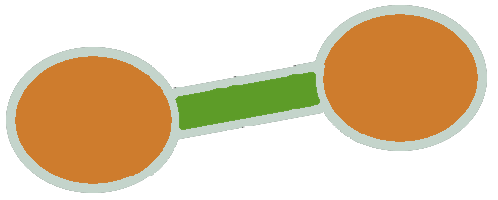Ninatoka
 enzyme
enzymeATP synthase
The ATP synthase (or F1F0 ATPase and also referred to as complex V) uses the free energy of an electrochemical gradient of protons (or sodium ions) generated by the respiratory chain to synthesize ATP. The ATP synthases comprise a very large group of highly conserved enzymes that are found in the bacterial cytoplasmic membranes, the thylakoid membranes of chloroplasts, and the inner membranes of mitochondria. Most members of the group use H+ as the coupling ion (the Propionigenium modestum enzyme is an example of the few ATP synthases that can use Na+ as the physiological coupling ion).
Ref:
David G. Whitehouse, Benjamin May, Anthony L. Moore, Respiratory Chain and ATP Synthase, Reference Module in Biomedical Sciences, Elsevier, 2019, , ISBN 9780128012383, https://doi.org/10.1016/B978-0-12-801238-3.95732-5. (https://www.sciencedirect.com/science/article/pii/B9780128012383957325) Abstract: The respiratory chain and ATP synthase are, in eukaryotic cells, located in the inner membrane of mitochondria. Mitochondria are oval-shaped organelles, typically 1–2μm long and 0.5μm in diameter, whose principal cellular functions are to generate energy, in the form of ATP and carbon skeletons for biosynthetic purposes. The shape and appearance of mitochondria vary considerably and these organelles appear to be most numerous in mammalian tissues with a high-energy demand (heart, liver, muscle, and brain and in rapidly dividing plants cells). The respiratory chain functions to oxidize NADH (+H+) and FADH2 and reduce molecular oxygen to water. These functions are electron transfer (electromotive) processes and result in a substantial release of energy, which generates a proton-motive force that is used to drive the ATP synthase in the forward direction thereby synthesizing ATP for use in cellular reactions. Keywords: ATP synthase; Binuclear center; Cytochrome; NADH dehydrogenase; Proton-motive force; Respiratory chain; Ubiquinone
Join Ninatoka!!
NinatoKa's goal is to support you as a therapist in unravelling the illness pathway from symptoms to cause, and to help you detect potential interventions.
Go to Explore to start your discovery!
Go to Learn to scroll through newly added data.
Go to Contribute to contribute to the Ninatoka database.
You can rate content up or down and add comments if you agree or disagree.



